
Concept explainers
a.
To draw: a
a.
Explanation of Solution
Given:
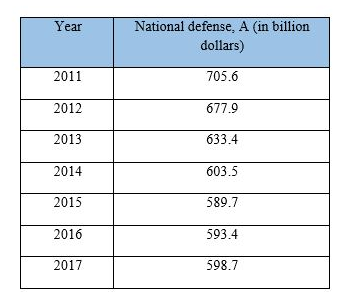
Graph:
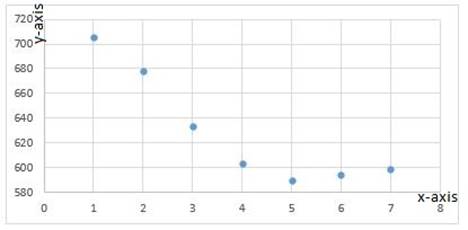
Interpretation:
The given plot shows that the budget for national defense has decreased approximately uniformly from 2011 up to 2015 and has been almost constant from 2015 to 2017 with small variations.
b.
To find: a quadratic model for the given data.
b.
Explanation of Solution
Given:
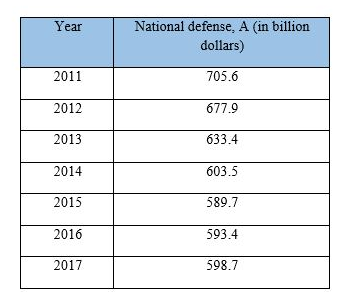
Graph:
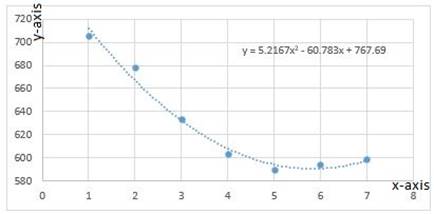
Interpretation:
Looking at the overall movement of graph, it appears almost following the quadratic model with small variation.
The equation of the graph comes out to be 1y13y
c.
To find: a quadratic model with the scatter plot from part (a).
c.
Explanation of Solution
Given:
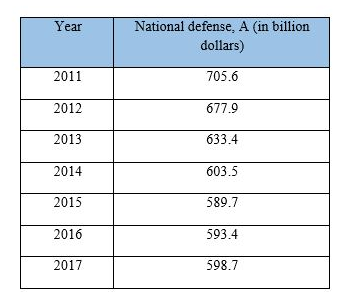
Graph:
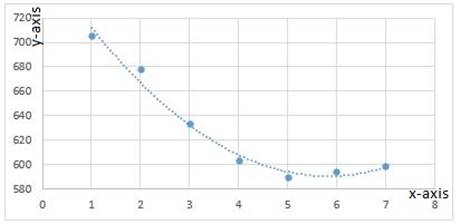
Interpretation:
Looking at the overall movement of graph, it appears almost following the quadratic model with small variation.
d.
To find: the approximate spending on national defense each year using quadratic model of the data.
d.
Explanation of Solution
Given:
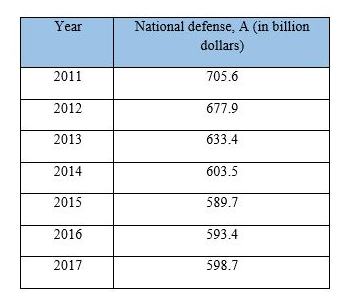
Graph:
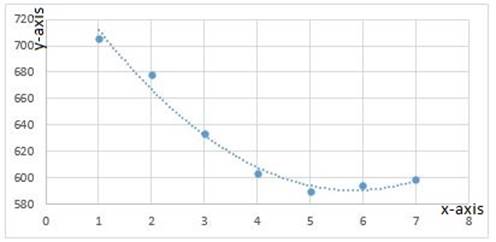
Interpretation:
From the graph the approximate spending on national defense in each year is given in following table
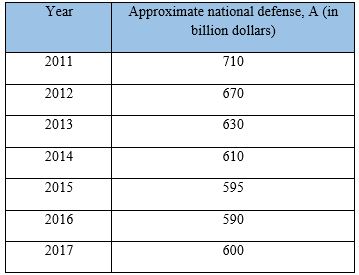
Conclusion:
Comparing the approximate data from the graph with the actual data, it is observed that the variation is not more than 10 at any instant.
Though the differences are substantial at some point, the quadratic model still fits much better than any other model because of how closely it follows the data.
Further, it can also be used to predict the future movement of the curve.
e.
To compare estimated data from the quadratic model with the actual data.
e.
Explanation of Solution
Given:
The estimated data and the actual data are given in the table below.
Actual data
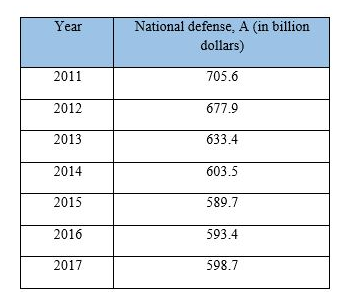
Estimated data.
On a close observation of the difference between the estimated data and the actual data, it seems that nowhere the difference was more than 10, which is an indication of an almost fit model for the data.
The quadratic model follows closely with the movement of actual curve.
Thus, the model is good fit for the given data.
Conclusion:
Quadratic model is good fit for the data as the difference between two values is not constant but rather changes with almost constant proportion.
Chapter 2 Solutions
PRECALCULUS W/LIMITS:GRAPH.APPROACH(HS)
- Write an equation for the polynomial graphed below. It will probably be easiest to leave your "a" value as a fraction. 8 7 + 9+ H 6 5 4 3 + 3 2 1 (-30) (-1,0) (1,0) (3,0) + -5 -4 -3 -2 2 3 4 7 2 -1 -2 3 (0,-3) f(x) = 456 -4 -5 -6+arrow_forwardWrite an equation for the polynomial graphed below 5+ 4 - 3 2 1 + + -5 4-3 -2 -1 1 2 3 4 5 -1 -2 y(x) = -3 -4 5 -5+ Qarrow_forwardWrite an equation for the polynomial graphed below 6+ 5 + -5 -4 3 y(x) = 4 3 2 1 -1 1 1 -1 -2 -3 -4 -5 2 3 4 5arrow_forward
- Write an equation for the polynomial graphed below 5+ 4 3 1 + + + -5-4-3-2 1 13 4 5 -1 -2 -3 -4 -5+ 4 5 Q y(x) =arrow_forward3. Solve the inequality, and give your answer in interval notation. - (x − 4)³ (x + 1) ≥ 0arrow_forward1. Find the formula to the polynomial at right. Show all your work. (4 points) 1- 2 3 сл 5 6 -4 -3 -2 -1 0 2 3arrow_forward
- 2. Find the leading term (2 points): f(x) = −3x(2x − 1)²(x+3)³ -arrow_forward1- √ √ √³ e³/√xdy dx 1 cy² 2- √ √² 3 y³ exy dx dy So 3- √ √sinx y dy dx 4- Jo √² Sy² dx dyarrow_forwardA building that is 205 feet tall casts a shadow of various lengths æ as the day goes by. An angle of elevation is formed by lines from the top and bottom of the building to the tip of the shadow, as de seen in the following figure. Find the rate of change of the angle of elevation when x 278 feet. dx Round to 3 decimal places. Γ X radians per footarrow_forward
- Use the information in the following table to find h' (a) at the given value for a. x|f(x) g(x) f'(x) g(x) 0 0 0 4 3 1 4 4 3 0 2 7 1 2 7 3 3 1 2 9 4 0 4 5 7 h(x) = f(g(x)); a = 0 h' (0) =arrow_forwardUse the information in the following table to find h' (a) at the given value for a. x f(x) g(x) f'(x) g'(x) 0 0 3 2 1 1 0 0 2 0 2 43 22 4 3 3 2 3 1 1 4 1 2 0 4 2 h(x) = (1/(2) ²; 9(x) h' (3)= = ; a=3arrow_forwardThe position of a moving hockey puck after t seconds is s(t) = tan a. Find the velocity of the hockey puck at any time t. v(t) ===== b. Find the acceleration of the puck at any time t. -1 a (t) = (t) where s is in meters. c. Evaluate v(t) and a (t) for t = 1, 4, and 5 seconds. Round to 4 decimal places, if necessary. v (1) v (4) v (5) a (1) = = = = a (4) = a (5) = d. What conclusion can be drawn from the results in the previous part? ○ The hockey puck is decelerating/slowing down at 1, 4, and 5 seconds ○ The hockey puck has a constant velocity/speed at 1, 4, and 5 seconds ○ The hockey puck is accelerating/speeding up at 1, 4, and 5 secondsarrow_forward
 Calculus: Early TranscendentalsCalculusISBN:9781285741550Author:James StewartPublisher:Cengage Learning
Calculus: Early TranscendentalsCalculusISBN:9781285741550Author:James StewartPublisher:Cengage Learning Thomas' Calculus (14th Edition)CalculusISBN:9780134438986Author:Joel R. Hass, Christopher E. Heil, Maurice D. WeirPublisher:PEARSON
Thomas' Calculus (14th Edition)CalculusISBN:9780134438986Author:Joel R. Hass, Christopher E. Heil, Maurice D. WeirPublisher:PEARSON Calculus: Early Transcendentals (3rd Edition)CalculusISBN:9780134763644Author:William L. Briggs, Lyle Cochran, Bernard Gillett, Eric SchulzPublisher:PEARSON
Calculus: Early Transcendentals (3rd Edition)CalculusISBN:9780134763644Author:William L. Briggs, Lyle Cochran, Bernard Gillett, Eric SchulzPublisher:PEARSON Calculus: Early TranscendentalsCalculusISBN:9781319050740Author:Jon Rogawski, Colin Adams, Robert FranzosaPublisher:W. H. Freeman
Calculus: Early TranscendentalsCalculusISBN:9781319050740Author:Jon Rogawski, Colin Adams, Robert FranzosaPublisher:W. H. Freeman
 Calculus: Early Transcendental FunctionsCalculusISBN:9781337552516Author:Ron Larson, Bruce H. EdwardsPublisher:Cengage Learning
Calculus: Early Transcendental FunctionsCalculusISBN:9781337552516Author:Ron Larson, Bruce H. EdwardsPublisher:Cengage Learning





